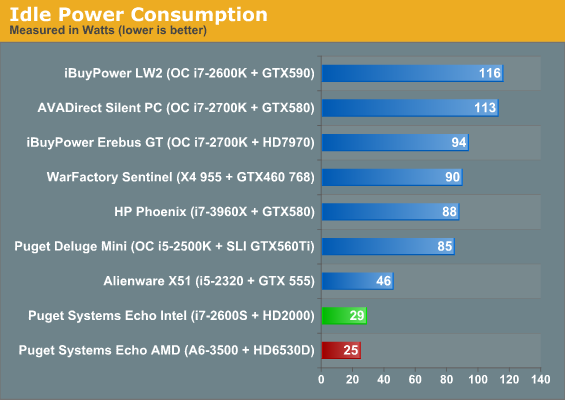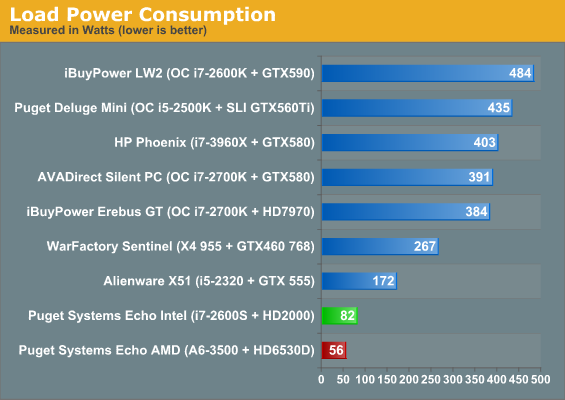Puget Systems Echo: Intel and AMD Showdown at 65 Watts
by Dustin Sklavos on March 21, 2012 2:35 AM EST- Posted in
- Systems
- AMD
- Intel
- Mini ITX
- Sandy Bridge
- Llano
- boutique
- Mini-Tower
Build Quality and Part Selection
Given the small nature of the Antec ISK-110 enclosures Puget Systems employs for their Echo I systems, it's not going to be much of a surprise that there's really only so much they can do to make build quality stand out. For what it's worth, the systems are put together as well as one can expect. Both use stock coolers from AMD and Intel, but given the low TDPs of the two processors (as well as the cramped confines of the enclosure) these coolers are never given much of a workout. Cabling is routed as well as can be expected, and Puget Systems filled both of the 2.5" drive bays. These systems really are packed to the gills.
.jpg)
This is a good time to bring up one of the ways Puget Systems distinguishes themselves from other boutiques, though. If you opt to configure a system on their site, you're going to find the number of available components substantially lower than you will from any other boutique. This has to do with their validation procedures; Puget is extremely picky about the parts they include in the desktops they ship and while I'd like to see this confidence reflected in a longer warranty than just one year, I've seen enough of their data (and their customer feedback) to corroborate their claims. It's the reason you only see Intel SSDs in their systems, for example.
It's also part of the reason why our AMD system is fighting a bit of an unfair fight, a point we brought up with Puget Systems and one they recognized. It's well known that Llano will use all the memory bandwidth it can get its hands on, while Sandy Bridge is much less sensitive. Puget hasn't qualified any 8GB DDR3-1600 DIMMs for deployment in any of their builds, and so they erred on memory capacity instead of speed. In conversations via e-mail, they even admitted this was probably a mistake in this instance. The problem is that they also don't offer any 2GB or 4GB DDR3-1600 DIMMs for the AMD-based system, either, when they do have 4GB DDR3-1600 DIMMs qualified for other builds.
As an aside, I did contact Puget Systems and ask why their parts warranty period was so limited compared to other boutiques, and their rationale is actually a fairly sound one: there's just no guarantee that the replacement parts will continue to be available for three years, given how fast hardware turns over in this industry. They don't feel a standard three year warranty is something they can in good conscience live up to, and so the three year warranty upgrade they offer is actually in place to cover the costs of offering brand new kit to replace defunct hardware should the need arise.
Heat and Noise
While I wasn't expecting too much in the way of thermal issues even with the stock cooling, I felt like noise could've gone either way when I pulled the two Echo systems out of their boxes. The side panel above the motherboard is completely ventilated, allowing fresh air to circulate inside the enclosure. That's great for cooling, but does absolutely nothing to muffle noise.
Thankfully, the circulating cool air does wonders to keep either heatsink's fan from having to work particularly hard. Neither system is actually audible while running unless you put your ear up to the open side; any kind of ambient noise in the room will muffle them. The result is that both systems never see temperatures above the low 60C on the cores, and noise is essentially a non-issue unless you're looking for a "silent" system.
Power Consumption
Most of the test results up to this point have been fairly predictable, but power consumption was a big surprise and a pretty stunning upset. Rather than build you up to it, I'll just show you.


At both idle and load, the AMD-based system beats the Intel-based one. Look at the load numbers in particular; the A6-3500 is able to beat the Intel Core i7-2600S by nearly thirty watts. I expected both to be frugal, but the A6-3500 is actually performing well under its rated wattage.


_thumb.jpg)
_thumb.jpg)
_thumb.jpg)
_thumb.jpg)
_thumb.jpg)
_thumb.jpg)








62 Comments
View All Comments
BSMonitor - Wednesday, March 21, 2012 - link
Why wouldn't they go down the road of using a mobile CPU for these types of systems?? They are already using customized motherboards. Seems like there are plenty of Core i7's with HD3000 in the $310 CPU range.frozentundra123456 - Wednesday, March 21, 2012 - link
Sounds like a great idea to me. A mobile chip with the HD3000 might even be a better balanced Intel system than the one they tested which if too strongly biased toward the CPU.silverblue - Thursday, March 22, 2012 - link
A mobile CPU would make plenty of sense here on both sides, along with SO-DIMMs for the AMD setup.Death666Angel - Wednesday, March 21, 2012 - link
Considering the price differences and the different markets the AMD APU and Intel CPU play at, these results are expected. It would have been nice to see the A8 65W APU with its superior IGP and more cores and higher clock. But that thing is seriously hard to get.I settled for a A6-3500 in my HTPC. It was much cheaper than any Intel solution at the time, the IGP is more important to me than more CPU power and undervolted it uses about as much juice as any Intel CPU. And this way I can support AMD some and increase competition (I use Intel in my desktop machine and my Laptops).
krumme - Wednesday, March 21, 2012 - link
For me Dustin just writes the best review currently on the web, far from the usual we need 7870 oc to get the job done, that doesnt reflect normal user behavior.This review, as the others from Dustin, is usufull for recommending solutions for family and friends,
except the minor detail i dont think they would care about the next wonder from AMD or Intel the same way we do :)
Interesting products. Then add we got some surprising power numbers.
All delivered in delightfull english
Thank you
Jamahl - Wednesday, March 21, 2012 - link
Thanks for this review, I've been looking at the A6-3500 as a possible build (as a reseller) and I'm pretty happy with the results here - especially the power draw ones.Jamahl - Wednesday, March 21, 2012 - link
What exactly were you running while testing power consumption btw?Dustin Sklavos - Thursday, March 22, 2012 - link
AIDA64's stress test, hitting the CPU and GPU simultaneously.Luscious - Wednesday, March 21, 2012 - link
I'm really REALLY surprised why the writer didn't push Puget for not using the i5-2405S in such a build - lack of knowledge?The 2405S is also a 65W part, slightly slower at 2.5GHz, only has 6MB Cache, but it does dish up HD3000 graphics. If I were building a mini-ITX system for a HTPC, this would be the CPU I would choose.
If 1080p gaming was my concern, I wouldn't even look at a mini-ITX enclosure...
Dustin Sklavos - Thursday, March 22, 2012 - link
Our thought process working with Puget was to just crank out the most powerful systems we could on the AMD and Intel sides. What's interesting, I think, and I touched on this a little in the review...you can't really say anything's just "the most powerful" anymore, and the review proves it. As a result, the comparison did suffer a little, but I'd like to think the information gleaned was useful nonetheless.